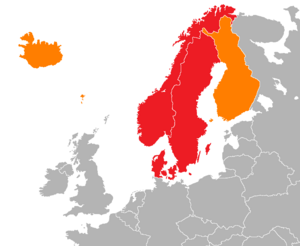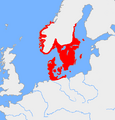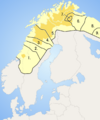Scandinavia facts for kids
Quick facts for kids
Scandinavia
|
|
|---|---|

Satellite photo of the Fennoscandian Peninsula and Denmark, as well as other areas surrounding the Baltic Sea, in March 2002.
|
|
| Languages | |
| Demonym(s) | Scandinavian |
| Composition | Sometimes also: Nordic territories that are not part of Scandinavia: |
| Internet TLD | |
Scandinavia is a region in northern Europe. It usually includes the countries of Norway, Sweden, and Denmark. These countries share similar languages, called North Germanic languages. People from these countries can often understand each other's languages. Sometimes, the term "Scandinavia" is also used to describe the land itself, which might include Finland.
Contents
The Scandinavian Peninsula is a large piece of land. It stretches west from northern Europe. This peninsula includes Norway, Sweden, and parts of Finland. It is also known as Fennoscandia. Denmark is considered part of Scandinavia, even though it's not on the peninsula. This is because Danish is a Scandinavian language, but Finnish is not.
Understanding the Nordic Countries
The term Nordic countries is a wider geographical term. It includes Norway, Sweden, Denmark (and the Faroe Islands), Finland, and Iceland. These five countries work together on political and cultural projects. They do this through the Nordic Council.
Denmark, Sweden, and Finland are members of the European Union. However, only Finland uses the euro currency. The other Nordic countries use their own money, called krone or krona. Norway and Iceland are not in the EU, but they are members of NATO. Denmark is the only country that belongs to both the EU and NATO.
The Scandinavian Peninsula has few people living there. It is covered with large forests of pine, birch, and spruce trees. The western and northern parts are mountainous. The Scandinavian mountains are some of the oldest in the world. Galdhøpiggen in Norway is the tallest mountain.
Denmark is the smallest Scandinavian country. It has more people living in it, and most of its land is used for farming. Sweden is the largest Scandinavian country. It has many lakes. Its landscape changes from flat lands in the south to mountains in the west. In the far north, there is tundra.
The northern parts of Scandinavia and Finland are called Lapland. This is where the Sami people live. Some Sami still herd reindeer, as they have for hundreds of years. Most Sami now live in modern ways, like other Scandinavians.
Many people think of the Vikings when they hear about Scandinavians. Vikings lived during the Middle Ages. Vikings from Sweden were known as traders. They traveled far, even to what is now Ukraine. They created trade routes to bring goods from the Middle East to Scandinavia.
Vikings from Norway were famous explorers. They crossed the North Atlantic in their longships. They settled in Iceland and Greenland. Norwegian explorers even reached the east coast of what is now Canada. They started a colony there, but it only lasted a few years.
Vikings from Denmark had a big impact on England. Danish raiders attacked England many times. They demanded payments called "Danegeld" (Danish gold). Priests and bishops along England's eastern coast prayed: "deliver us, O Lord, from the wrath of the Norsemen!"
Modern Views of Vikings
The way we imagine Vikings today was mostly created much later. In the 1800s, during the Romantic period, people like Richard Wagner invented these ideas. They showed Vikings in operas and art. Often, these Vikings wore furs and helmets with wings or horns. They were also shown drinking from large horns.
The name "Scandinavia" usually means Denmark, Norway, and Sweden. These three countries are on or near the Scandinavian peninsula. However, Finland and Iceland are sometimes also thought of as part of Scandinavia.
The people who live in Scandinavia usually do not consider Finland and Iceland to be Scandinavian countries. Instead, they see them as part of the larger group called the Nordic countries.
Images for kids
-
Galdhøpiggen is the highest point in Scandinavia and is a part of the Scandinavian Mountains.
-
The original areas inhabited (during the Bronze Age) by the peoples now known as Scandinavians included what is now Northern Germany (particularly Schleswig-Holstein), all of Denmark, southern Sweden, the southern coast of Norway and Åland in Finland while namesake Scania found itself in the centre.
See also
 In Spanish: Escandinavia para niños
In Spanish: Escandinavia para niños






